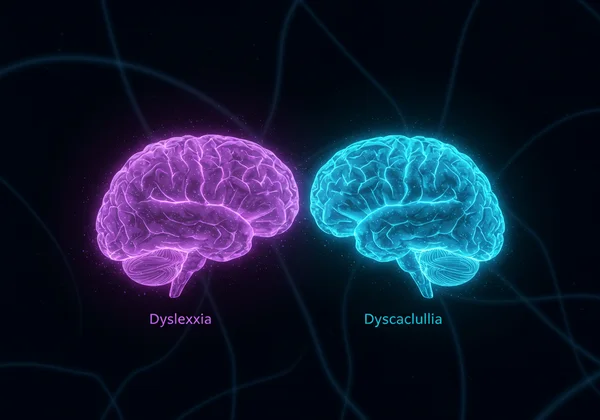Dyscalculia & Dyslexia: Understanding Math Learning Disabilities and Dyslexia Screening
Do you find that numbers feel like a foreign language? For many, the persistent struggle with math isn't about a lack of effort but may be related to dyscalculia, a specific math learning disability. How do you test for learning difficulties that affect numbers instead of letters? This comprehensive guide explores the world of dyscalculia, its signs, and its surprising connection to dyslexia, offering clarity for parents, educators, and adults seeking answers. Understanding these challenges is the first step toward unlocking true potential, and an initial screening can provide valuable insights. You can start your dyslexia screening with a free assessment today.
Understanding Dyscalculia: A Specific Math Learning Disability
While many people joke about being "bad at math," dyscalculia is a legitimate and persistent difficulty with mathematical concepts. It's a neurodevelopmental condition that affects a person's ability to acquire arithmetic skills. Individuals with dyscalculia may struggle to understand number-related concepts or use symbols and functions needed for success in mathematics. This condition is not related to intelligence; in fact, many with dyscalculia have average or above-average IQs.
The core issue often lies in a weakness in "number sense," the intuitive understanding of numbers, their magnitude, and their relationships. While others might instantly grasp that 8 is larger than 5, someone with dyscalculia may have to pause and consciously process that information. This foundational challenge can create a ripple effect, making more complex math operations feel nearly impossible.

More Than Just "Bad at Math": Defining Dyscalculia
It's crucial to move beyond simplistic labels. Dyscalculia is not about being lazy or unintelligent. Instead, it involves specific challenges with mathematical reasoning and processing. Key characteristics include:
- Difficulty with Number Sense: Trouble grasping quantities, comparing numbers (which is bigger?), and understanding the order of numbers.
- Struggles with Math Facts: Inability to memorize basic arithmetic facts like multiplication tables or simple addition (e.g., 2+3=5).
- Challenges with Procedures: Difficulty following multi-step math problems or remembering the sequence of operations.
- Visual-Spatial Confusion: Trouble with telling time on an analog clock, understanding graphs, or navigating directions (left vs. right).
Understanding this distinction is vital. It reframes the problem from a character flaw to a recognizable learning difference that requires specific support strategies.
Common Misconceptions About Math Learning Difficulties
To effectively support learners, we must first debunk common myths surrounding learning challenges. Many believe that a child will simply "grow out of" their math struggles or that more drill-and-practice is the only solution. For someone with dyscalculia, these approaches can increase anxiety and reinforce feelings of failure.
Another misconception is that all math difficulties are the same. In reality, a student might struggle due to math anxiety, inadequate instruction, or other learning differences like dyslexia or ADHD. Identifying the root cause is essential for providing the right kind of help. Recognizing these nuances helps create a more empathetic and effective support system. If you suspect any learning challenge, a free dyslexia test can be a helpful starting point to understand a broader cognitive profile.
Identifying Signs of Dyscalculia Across Ages
The signs of dyscalculia can manifest differently depending on a person's age and the demands placed upon them. Recognizing these signs early is crucial for providing timely intervention and support, which can prevent years of frustration and low self-esteem. From a young child struggling with counting to an adult avoiding tasks involving numbers, the indicators are often consistent, though their context changes.
Early Indicators in Young Children (Pre-K to Elementary)
For parents of young children, spotting the early signs can make a significant difference. While all children develop at their own pace, persistent counting difficulties and other related issues may warrant a closer look.
-
Trouble learning to count and skipping numbers long after peers have mastered it.
-
Difficulty recognizing printed numbers (e.g., confusing 3 and 8).
-
Struggles to connect a number symbol (5) to the quantity it represents (five blocks).
-
Heavy reliance on finger counting for simple calculations.
-
Inability to recognize patterns or sort items by size, shape, or color.

Recognizing Dyscalculia in Older Students & Adults
As academic demands increase, the signs of dyscalculia often become more pronounced. For teens and adults, these challenges can spill over into daily life, causing significant math anxiety and avoidance of number-related tasks.
- Difficulty with abstract math concepts like fractions and algebra.
- Trouble estimating costs, calculating tips, or managing a budget.
- Challenges with telling time, reading schedules, or measuring ingredients.
- Poor financial literacy, leading to difficulties with banking or paying bills.
- A tendency to get lost easily or struggle with reading maps and directions.
For many adults who have struggled silently for years, identifying these signs can be a moment of profound relief—an explanation for lifelong challenges.
Impact on Daily Life and Academic Performance
The impact of dyscalculia extends far beyond the classroom. It can affect a person's confidence, career choices, and ability to manage everyday tasks. Simple activities like splitting a bill with friends, understanding a sale at a store, or helping a child with homework can become sources of stress. The need for real-world math skills is constant.
Academically, students may fall further behind as math curriculum becomes more complex, leading to poor grades and a fear of subjects like science and economics. By providing understanding and support, we can empower individuals to develop coping strategies and use tools that help them navigate these challenges successfully. Taking an initial step like an online dyslexia screening can help identify if other co-occurring difficulties are present.
Dyslexia and Dyscalculia: Exploring Their Interconnection
It's not uncommon for a person to experience challenges with both reading and math. The connection between dyslexia and dyscalculia is well-documented, with research suggesting that a significant percentage of individuals with one condition also show signs of the other. Understanding this overlap is key to providing holistic support that addresses a learner's complete cognitive profile.
Why Do Learning Difficulties Often Co-Occur? (Comorbidity Explained)
The term for when two or more conditions occur in the same person is "comorbidity." Both dyslexia and dyscalculia are neurodevelopmental conditions, meaning they originate from differences in brain structure and function. They are not separate, isolated issues but are often linked by underlying cognitive processes.
This doesn't mean one causes the other. Rather, they may share common genetic predispositions or stem from inefficiencies in the same brain networks responsible for processing symbols, whether they are letters or numbers. Recognizing this comorbidity is crucial because addressing only one learning difference may leave the other to continue causing struggles. A broad-based approach to screening, like the one offered by a dyslexia test for kids, can help flag potential areas of concern.

Shared Cognitive Challenges Between Reading and Math
The link between reading and math difficulties often comes down to shared cognitive skills. Several core abilities are essential for both reading proficiency and mathematical competence.
- Working Memory: The ability to hold and manipulate information temporarily. This is needed for remembering steps in a math problem and for holding onto sentence structure while reading.
- Processing Speed: The pace at which you can take in, understand, and respond to information. Slower processing can make it hard to keep up in class for both subjects.
- Sequencing: The ability to perceive and remember the order of items, whether it's letters in a word (c-a-t) or numbers in a calculation (1, 2, 3).
- Verbal Processing: Many math problems are presented as word problems, requiring strong language skills to decode the question before even starting the calculation.
When these foundational skills are weak, they can impact learning across multiple domains.
Effective Support Strategies for Dyscalculia
The good news is that with the right strategies and support, individuals with dyscalculia can succeed. The goal is not to "cure" the condition but to build skills, develop compensatory strategies, and use tools that make math accessible. A positive, encouraging environment is the first and most important step.
Strategies for Parents to Support Math Learning at Home
Parents can play a powerful role in building their child's confidence. The focus should be on making math fun and relevant to daily life.
- Use Concrete Examples: Use physical objects like blocks, coins, or food to represent numbers and math problems.
- Play Fun Math Games: Board games, card games, and online math games can reinforce number sense without the pressure of worksheets.
- Connect Math to Real Life: Involve your child in cooking (measuring), shopping (calculating costs), or planning a trip (reading schedules).
- Praise Effort, Not Just Accuracy: Celebrate persistence and small victories to reduce math anxiety.
Classroom Accommodations for Educators Supporting Dyscalculic Students
Educators are on the front lines of supporting students with learning differences. Simple accommodations can make a world of difference.
- Allow Use of Tools: Permit calculators, graph paper to align numbers, and lists of math facts.
- Provide Extra Time: Give students more time on tests and assignments to reduce pressure.
- Use Multisensory Teaching: Incorporate sight, sound, and touch into lessons. For example, use rhymes to teach math facts or have students draw out problems.
- Break Down Instructions: Present information in small, sequential steps, both verbally and in writing.
Creating an inclusive classroom helps all students thrive.
The Role of Assistive Technology in Math Learning Support
Today, a wide range of math tools and apps can help individuals with dyscalculia. Assistive technology can act as a bridge, helping users bypass their challenges to focus on higher-level concepts.
-
Calculator Apps: Modern calculators on phones and computers can handle multi-step problems.
-
Math-to-Speech Software: Reads numbers and equations aloud to help auditory learners.
-
Virtual Manipulatives: Digital blocks and charts that allow users to visualize and interact with math concepts.
-
Graphing and Charting Tools: Helps organize information visually for problem-solving.

Embracing these tools empowers individuals, giving them the independence to tackle math-related tasks in school and in life.
Your Next Steps Towards Understanding and Support for Learning Differences
Understanding dyscalculia and its connection to dyslexia demystifies the struggles that many children and adults face. It's not about being "bad" at a subject; it's about having a brain that is wired differently. By identifying the signs, busting myths, and implementing effective strategies, we can create a supportive environment where every learner has the opportunity to unlock their full potential.
Recognizing the possibility of co-occurring learning differences is a critical part of this journey. Because reading and math skills are often linked by underlying cognitive processes, exploring one area can shed light on another. If you have concerns about your child's learning profile or your own, taking the first step is the most powerful thing you can do. Take our screening today to gain valuable insights into reading skills and begin the path toward understanding and empowerment.
Frequently Asked Questions About Dyscalculia and Learning Differences
How to identify and screen for dyscalculia?
Identifying dyscalculia starts with observing persistent difficulties with number sense, math facts, and calculations that are not aligned with the person's age or intelligence. The next step is a screening. While our platform focuses on dyslexia, many of the underlying cognitive skills are related. For a comprehensive view, a free dyslexia screening can be an excellent first step before seeking a formal evaluation from an educational psychologist who specializes in math learning disabilities.
What are the primary signs of dyscalculia in a 7-year-old?
In a 7-year-old, key signs include a continued reliance on finger counting for simple addition, difficulty understanding concepts like "greater than" or "less than," trouble remembering phone numbers or addresses, and struggles with telling time on an analog clock. They may also show anxiety when asked to do math-related activities.
Is an online screening accurate for learning difficulties like dyscalculia?
Online screenings are valuable tools for identifying potential risk factors. They are not a formal diagnosis but can provide a strong indication of whether further assessment is needed. It is crucial to choose a screening tool developed by experts. An online tool like ours provides a report that helps you understand potential challenges and guides you on the next steps, such as talking to a teacher or a specialist. Remember, a screening is the beginning of the conversation, not the end.
What is the cost of a formal dyscalculia assessment?
The cost of a formal assessment for dyscalculia can vary widely, often ranging from several hundred to a few thousand dollars. This evaluation is conducted by a qualified psychologist or specialist and involves a comprehensive battery of tests. This is why starting with a free, reliable online screening tool is a practical and accessible first step to determine if investing in a full assessment is necessary. You can get your free report to help inform your decision.